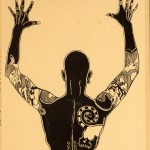By Adrienne Mayor (regular contributor)
 Archaeologists have found artistic representations in archaeological sites of the Shang to Han Dynasty periods (1500 BC to AD 220) reflecting tattooing practices. It is interesting that the earliest Chinese word for writing, wén, referred to tattoos. Evidence of tattooing customs among the nomadic steppe cultures of Central Asia–known to the ancient Greeks as Scythia–also appears in many Chinese chronicles.
Archaeologists have found artistic representations in archaeological sites of the Shang to Han Dynasty periods (1500 BC to AD 220) reflecting tattooing practices. It is interesting that the earliest Chinese word for writing, wén, referred to tattoos. Evidence of tattooing customs among the nomadic steppe cultures of Central Asia–known to the ancient Greeks as Scythia–also appears in many Chinese chronicles.
Several Chinese sources described tattoos as common body adornments among the “barbarian” nomads of the Northern and Western Wilderness, beyond the imperial borders of China. For example, in the Warring States and early Han period (about 475 BC to 87 BC), the Liji (“Record of Rites,”) reported on the “wild” tribes of mounted archers of Inner Asia: they ate meat, wore animal skins, and tattooed their foreheads. In the third to first centuries BC, the Zhan Guo Ce (“Intrigues of the Warring States”), stated that the Western horse-archers engraved their left shoulders with tattoos. The Nan Shih (“History of the Southern Dynasties”) of AD 630 refers to the steppes as the “Land of the Tattooed.” These “uncivilized” people marked themselves “with stripes and spots like wild beasts.” It also noted that Siberian peoples of “gigantic” stature wore tattoos that signified their courage and signaled their marital status.
The powerful confederation of nomad tribes of the West became known to the Chinese as Xiongnu. A Han history by Sima Qian (Shiji, “Records of the Historian,” 147-85 BC) recounts the emperor’s negotiations with the aggressive Xiongnu who exerted continuous pressure on China’s Western frontier. The nomads held the upper hand in the fifth to third centuries BC. To mollify them, Chinese rulers sent lavish tributes and Han princesses as wives to seal treaties. When Chinese ambassadors arrived with gifts, however, the nomad leaders demanded that the envoys be tattooed (me [mo] ch’ing, “to tattoo with black ink”) before they could meet the Shan-yu (“The Greatest,” chieftain).
The Chinese, like the ancient Greeks and Romans, considered tattooing a form of punishment, the mark of a slave or criminal. Even so, ancient Greek vase painters portrayed beautiful barbarian women decorated with tattoos. Permanent body markings evoked ambivalence. Likewise, the lines between tattoos that were shameful marks, heroic badges of honor, and beautiful decorations began to blur for the Chinese as their dealings with steppe nomads increased and some of steppe customs–such as riding warhorses and wearing trousers–began to influence Chinese culture. Acceptance of tattoos became more common, especially among Chinese travelers, traders, explorers, and envoys who interacted and lived among the nomads. “The Mission to the West” in the Han Shu by Zhang Qian (Chang K’ien), records that some Chinese envoys, for example Wang Wu, who was himself a northerner familiar with Xiongnu customs, readily agreed to receive tattoos in order to meet with nomad leaders.
About the author: A Research Scholar in Classics and History of Science, Stanford University. Adrienne Mayor is the author of The Poison King: Mithradates, Rome’s Deadliest Enemy, a nonfiction finalist for the 2009 National Book Award, and The Amazons: Lives and Legends of Warrior Women across the Ancient World (2014).
